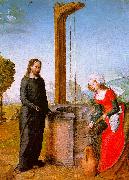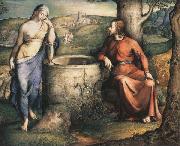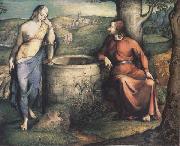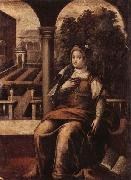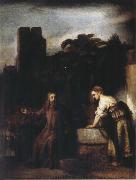
|
Juan de Flandes
|
|||
|
|
|||
| Flemish-born Spanish Northern Renaissance Painter, ca.1460-1519 South Netherlandish painter, active in Spain. Nothing is known of his life or work before he went to Spain, where he is first mentioned in a document of 1496 as Juan de Flandes, a painter in the service of Queen Isabella of Castile. Treasury accounts confirm that he held this position until the Queen death in 1504. On arriving in Spain, he must have lived in Burgos, where he certainly met MICHEL SITTOW, another painter in the Queen service, who had been at the Castilian court since 1492. | |||
|
|
|||
|
Christ and the Woman of Samaria Juan de Flandes1.jpg Painting ID:: 1224 |
Musee du Louvre, Paris | ||
|
|
|||
|
George Richmond
|
|||
|
|
|||
| English Painter, 1809-1896 Painter, draughtsman and engraver. He was a precocious draughtsman. In 1824 he entered the Royal Academy, London, the same year as Edward Calvert, who was a part-time student of Joseph Severn. Richmond first exhibited at the Academy in 1825 and that year met William Blake in the Highgate house of John Linnell (ii). Like his lifelong friend Samuel Palmer, Richmond fell under Blake's spell, comparing him to the Prophet Isaiah and forming close friendships with Blake's other disciples, including Calvert. He visited Palmer at Shoreham, chiefly in the summer of 1827, and both he and Calvert became prominent members of Palmer's band of ANCIENTS, who frequented the Kent village in the late 1820s and early 1830s. The tempera panel Abel the Shepherd (1826; London, Tate) is typical of Richmond's early paintings, which reflect the pronounced influence of both Blake and Palmer. They are painted in an archaic style and include Christian and literary themes and high-minded if obscure genre subjects such as the Eve of Separation (1830; Oxford, Ashmolean). The human figure was central to these pictures as it was not for Palmer, who expressed sentiment through landscape motifs. Richmond was also active as a draughtsman and miniaturist during this period; his Christ-like head of Palmer, in watercolour and gouache on vellum (London, N.P.G.), dates from 1829. | |||
|
|
|||
|
Christ and the Woman of Samaria new2/George Richmond-342589.jpg Painting ID:: 26351 |
mk49 1828 | ||
|
|
|||
|
George Richmond
|
|||
|
|
|||
| English Painter, 1809-1896 Painter, draughtsman and engraver. He was a precocious draughtsman. In 1824 he entered the Royal Academy, London, the same year as Edward Calvert, who was a part-time student of Joseph Severn. Richmond first exhibited at the Academy in 1825 and that year met William Blake in the Highgate house of John Linnell (ii). Like his lifelong friend Samuel Palmer, Richmond fell under Blake's spell, comparing him to the Prophet Isaiah and forming close friendships with Blake's other disciples, including Calvert. He visited Palmer at Shoreham, chiefly in the summer of 1827, and both he and Calvert became prominent members of Palmer's band of ANCIENTS, who frequented the Kent village in the late 1820s and early 1830s. The tempera panel Abel the Shepherd (1826; London, Tate) is typical of Richmond's early paintings, which reflect the pronounced influence of both Blake and Palmer. They are painted in an archaic style and include Christian and literary themes and high-minded if obscure genre subjects such as the Eve of Separation (1830; Oxford, Ashmolean). The human figure was central to these pictures as it was not for Palmer, who expressed sentiment through landscape motifs. Richmond was also active as a draughtsman and miniaturist during this period; his Christ-like head of Palmer, in watercolour and gouache on vellum (London, N.P.G.), dates from 1829. | |||
|
|
|||
|
Christ and the Woman of Samaria new2/George Richmond-422373.jpg Painting ID:: 26382 |
mk49 1828 Tempera on wood 41x49.8cm | ||
|
|
|||
|
unknow artist
|
|||
|
|
|||
|
|
|||
|
Christ and the woman of samaria new3/unknow artist-926558.jpg Painting ID:: 27565 |
mk56 oil on canvas Follower of Lodewijck Toeput,called il Pozzoserrato | ||
|
|
|||
|
REMBRANDT Harmenszoon van Rijn
|
|||
|
|
|||
| Born 1606, Died 1669.One of the great Dutch painters and printmakers of the 17th century, Rembrandt van Rijn is best known for his expressive use of light and shadow (also called chiaroscuro) in his many portraits. Raised in Leiden, he studied with Pieter Lastman (1583-1633) in Amsterdam, then returned to Leiden around 1625 and set up shop as a teacher and portrait artist. Sometime between 1630 and 1632 Rembrandt relocated to Amsterdam, where he spent the rest of his career. Though he had his detractors (some of whom considered him coarse and "low born"), Rembrandt was successful and famous during his lifetime, though he fell on financial hard times in his later years. He was a master printer and produced hundreds of group portraits and historical paintings, including The Anatomy Lesson of Dr. Tulp (1632), The Military Company of Captain Frans Banning Cocq (1642) and Aristotle with a Bust of Homer (1653). His portraits -- including a lifelong trail of intriguing and rather frank self-portraits -- reveal his interest in psychological study and continue to be admired as landmarks in Western art. The Military Company of Captain Frans Banning Cocq is also known as "The Night Watch" because it was thought the painting depicted a nighttime scene. When the painting was cleaned in the 1940s it became obvious that it depicted a daytime scene... He married Saskia van Ulenburgh (also Uylenburgh) in 1634. | |||
|
|
|||
|
Christ and the Woman of Samaria new10/REMBRANDT Harmenszoon van Rijn-728652.jpg Painting ID:: 34523 |
mk93 1655 Oil on panel 25x19 1/4in Metropolitan Museum of Art. New York | ||
|
|
|||
|
Also Buy::. For Following Paintings / Artists / Products, Please Use Our Search Online: |






